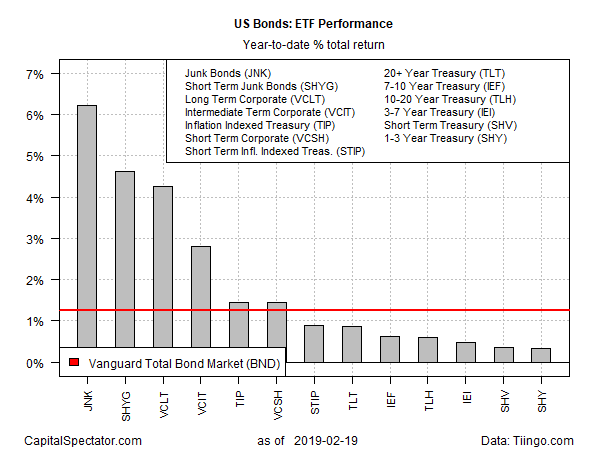The bull run in U.S. bonds shows no sign of slowing, based on year-to-date performances for a set of exchange-traded funds. All the major slices of fixed-income markets are posting gains through yesterday’s close (February 19), with junk bonds leading the field by a solid margin.
SPDR Barclays High Yield Bond (NYSE:JNK) ticked up to a new record high on Wednesday. For the year so far, JNK is up 6.2%. That’s a comfortable edge over the year’s second-best performer: a short-term portfolio of junk bonds via iShares 0-5 Year High Yield Corp Bond (SHYG), which is ahead 4.6% year to date.
In third place is Vanguard Long-Term Corporate Bond (NASDAQ:VCLT), a portfolio of investment-grade securities. The ETF is up 4.3% so far this year.
A tailwind is blowing across all the major U.S. bond buckets for investment-grade markets: Vanguard Total Bond Market (NYSE:BND) is ahead by a healthy 1.3% in 2019 through Wednesday’s close.
The weakest performer is enjoying a gain this year, too, via a 0.3% rise for iShares 1-3 Year Treasury Bond (NASDAQ:SHY).

What’s the source of the across-the-board gains for every corner of the U.S. bond market year to date? Most analysts identify the Federal Reserve’s recent decision to put its policy tightening plans on hold as a key catalyst.
To the extent that the Fed’s pause is driving bond prices higher (and yields lower), the bullish trend looks set to continue. According to this morning’s Fed funds futures market, the crowd is still pricing in very low odds of a rate hike for the rest of the year, based on CME data.
Next week’s update (Feb. 28) on U.S. gross domestic product (GDP) for last year’s fourth quarter is expected to reaffirm the case for the Fed’s decision to put rate hikes on hold. Using the Atlanta Fed’s GDPNow model (as of Feb. 14) as a guide, Q4 GDP growth is on track to decelerate to a sluggish 1.5% increase. If accurate, the Bureau of Economic Analysis will report the second straight quarter of softer growth for the U.S. economy.
Early estimates for this year’s Q1 also look relatively weak at the moment. Now-casting.com’s current projection sees GDP rising at a relatively modest 1.8% (based on the firm’s Feb. 15 update).
In short, there’s still a solid case for assuming that U.S. economic growth peaked last year with the strong 4.2% GDP increased in Q2.
Using current nowcasts as a guide also suggests that there’s still more than a trivial dose of risk in the market for betting against bonds.
